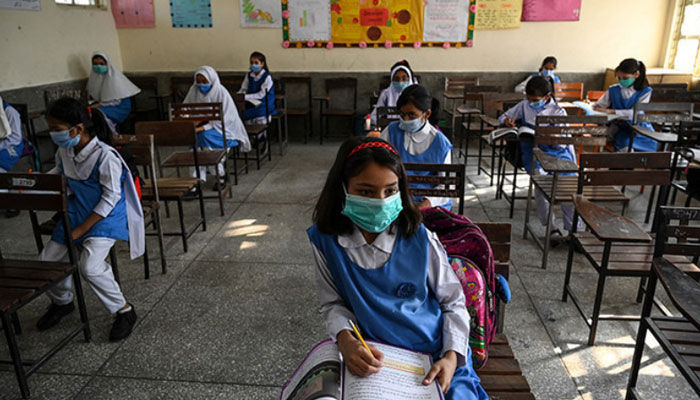Kids not immune to Covid carnage
LAHORE: Various studies and data have debunked the notion that Covid-19 does not harm children.
According to NCOC, the coronavirus has killed at least 44 children up to age 10. In Islamabad, 44 children were found Covid-19 positive, while the number of infected patients among adolescents above the age 11 was 49. Overall, 7052 children have been recorded with the Covid-19 infection in Pakistan.
In Lahore, 13 children died in Children’s Hospital which reported 18 coronavirus cases. Citing the Punjab health department, Covid-19 infected 75 children in March 2020 and the number of cases soared to 2875 in June. In March this year, the number of infected children was 4830. These numbers indicate the virus is rapidly infecting children. Cough, fever, flu, and body pains are common symptoms.
The report, from the American Academy of Pediatrics and the Children’s Hospital Association, counted more than 380,000 confirmed cases in children as of August 6 last year. The number rose to 3,540,000 on April 4 this year, with 12 per cent of the infect children being hospitalised. The US witnessed 67 death of up to 4-years-old children. Number of death in the age group of 5 to 15 was also 67.
In India, several hospitals are reporting a sharp rise in the number of children between the age of one and five landing up in hospitals. Unlike last year, the virus is affecting infants, with some as young as one-and-a-half months old getting admitted to hospital.
Dr Dhiren Gupta, Pediatric Intensivist at Sir Ganga Ram Hospital, told an Indian newspaper, “The virus is spreading to the pediatric age group in the current surge. The number of children coming to the hospital with Covid-19 has increased five times as compared to last year. We even have a three-month-old infant admitted to the ICU with Covid-19 and pneumonia. While we are getting swamped with young children and teenagers, the most affected age group is between one to five years in this category.” The most common symptoms observed in children include high fever, vomiting, diarrhea and headache.
Brazil has seen the virus killing 2060 children, including1302 infants. A child, Lucas, died because the Brazilian doctors had not conducted the Covid-19 test. The child had almost all symptoms of Covid with oxygen level dropping to 86. The test was not done timely because the child had no fever and when it was done it was too late. Lucas was transferred to a paediatric intensive care unit in Sobral, over two hours away, where he was diagnosed with a condition called multi-system inflammatory syndrome (MIS). This is an extreme immune response to the virus, which can cause inflammation of vital organs.
Experts say the syndrome, which affects children up to six weeks after they are infected with coronavirus, is rare, but leading epidemiologist Dr Fatima Marinho from the University of São Paolo, says that, during the pandemic, she is seeing more cases of MIS than ever before. Although it doesn't account for all deaths.
"It is important that doctors, even if they believe it is not Covid, do the test to eliminate the possibility," Lucas’s mother says, adding "A baby does not say what he is feeling, so we depend on tests."
Between February 2020 and 15 March 2021, Covid-19 killed at least 852 of Brazil's children up to the age of nine, including 518 babies under one year old, according to figures from the Brazilian Ministry of Health. But Dr Marinho estimates that more than twice this number of children died of Covid. A serious problem of underreporting due to lack of Covid testing is bringing the numbers down, she says.
The Royal College of Paediatrics and Child Health advises parents seek urgent help if their child has any of the following symptoms: —
Becoming pale, mottled and feeling abnormally cold to the touch, has pauses in their breathing (apnoeas), irregular breathing pattern or starts grunting, severe difficulty in breathing, becoming agitated or unresponsive; is going blue round the lips, has a fit/seizure, becomes extremely distressed (crying inconsolably despite distraction), confused, very lethargic (difficult to wake) or unresponsive, develops a rash that does not disappear with pressure (the 'Glass test'), has testicular pain, especially in teenage boys.
According to United Nations Children’s Fund’s (Unicef) recent report – Direct and Indirect Effects of Covid-19 Pandemic and Response in South Asia — disruption in healthcare services may have contributed to 228,000 additional deaths of children under five years in 2020. These disruptions ranged from nutrition benefits to immunisation and rising food insecurity due to the novel coronavirus disease (COVID-19) restrictions. The analysis focused on South Asia’s six most populous countries: Afghanistan, Bangladesh, India, Nepal, Pakistan and Sri Lanka. These are home to some 1.8 billion people.
There was an 80 per cent drop in the number of young children treated for severe malnutrition in Nepal and Bangladesh in 2020 compared to that in 2019. The number of children immunised in India and Pakistan dropped by 35 per cent and 65 per cent respectively, the report noted.
Child mortality rose 15.4 per cent in India, followed by Bangladesh (13 per cent). Increase in maternal deaths was the sharpest in Sri Lanka (21.5 per cent), followed by Pakistan’s 21.3 per cent. It estimated that some 3.5 million additional unwanted pregnancies, including 400,000 among teenagers, happened in 2020 due to poor or no access to contraception.
Nearly 89,434 additional stillbirths were anticipated as a result of reduced coverage of essential services across the whole of South Asia. The largest increase in the number of stillbirths may have been in India (60,179, 10 per cent increase from 2019), followed by Pakistan (39,752, 11 per cent increase) and Bangladesh (5,502, 3 per cent increase).
The report recommended a number of measures — including prioritisation of services for pregnant women, adolescents and children; strengthening food systems to ensure a resilient supply of nutritious and affordable foods; and delivery of immunisations and ensuring adequate personal protective equipment supply.
-
 Relieve Eczema Symptoms This Winter With Simple Steps
Relieve Eczema Symptoms This Winter With Simple Steps -
 Prince Harry Faces Marital Tensions As King Charles Offers Olive Branch
Prince Harry Faces Marital Tensions As King Charles Offers Olive Branch -
 South Korea, Italy Strengthen Ties To Bolster AI Technology, Business, Defence Cooperation
South Korea, Italy Strengthen Ties To Bolster AI Technology, Business, Defence Cooperation -
 Elon Musk Shares Crucial Advice As China’s Birth Rate Hits Record Low Since 1949
Elon Musk Shares Crucial Advice As China’s Birth Rate Hits Record Low Since 1949 -
 Kelly Clarkson Finally Quitting Morning Show?
Kelly Clarkson Finally Quitting Morning Show? -
 'Confident' Prince Harry Breaks Silence After Returning To Britain
'Confident' Prince Harry Breaks Silence After Returning To Britain -
 James Gunn Reveals What Caused Wonder Woman Casting Rumors
James Gunn Reveals What Caused Wonder Woman Casting Rumors -
 Tesla Emerges Early Winner As Canada Welcomes Chinese EVs: Here’s Why
Tesla Emerges Early Winner As Canada Welcomes Chinese EVs: Here’s Why -
 New Hope For People With Obesity As Failed Drug Offers Cure
New Hope For People With Obesity As Failed Drug Offers Cure -
 Prince Harry Considering ‘half-in, Half-out’ Royal Role Amid UK Trip?
Prince Harry Considering ‘half-in, Half-out’ Royal Role Amid UK Trip? -
 CBS Finally Airs Trump’s Full Interview 'pulled' Earlier After White House Threatens To Sue
CBS Finally Airs Trump’s Full Interview 'pulled' Earlier After White House Threatens To Sue -
 Robert Irwin Gets Honest About Being In South Africa After 'DWTS' Run In LA
Robert Irwin Gets Honest About Being In South Africa After 'DWTS' Run In LA -
 Queen Elizabeth’s Icy Response To Andrew, Jeffrey Epstein Scandal Revealed
Queen Elizabeth’s Icy Response To Andrew, Jeffrey Epstein Scandal Revealed -
 Trump Vows To Neutralize ‘Russian Threat’ From Greenland, Raising Arctic Stakes
Trump Vows To Neutralize ‘Russian Threat’ From Greenland, Raising Arctic Stakes -
 Green Day Revealed As Super Bowl 2026 Opening Act
Green Day Revealed As Super Bowl 2026 Opening Act -
 Trump's Greenland Tariff ‘blackmail’ Sparks EU Retaliation: Is ‘trade Bazooka’ Next?
Trump's Greenland Tariff ‘blackmail’ Sparks EU Retaliation: Is ‘trade Bazooka’ Next?




